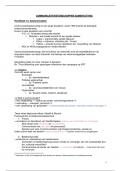Notes de cours
Management Study Notes
- Cours
- Management
- Établissement
- Vrije Universiteit Brussel (VUB)
This is a document containing all the information you need to know for the Management Exam in year I. It contains both the information of the slides provided by the teacher, as well as class notes that clarify the contents of the slides (yes, including the recordings in case you didn't manage to wa...
[Montrer plus]












